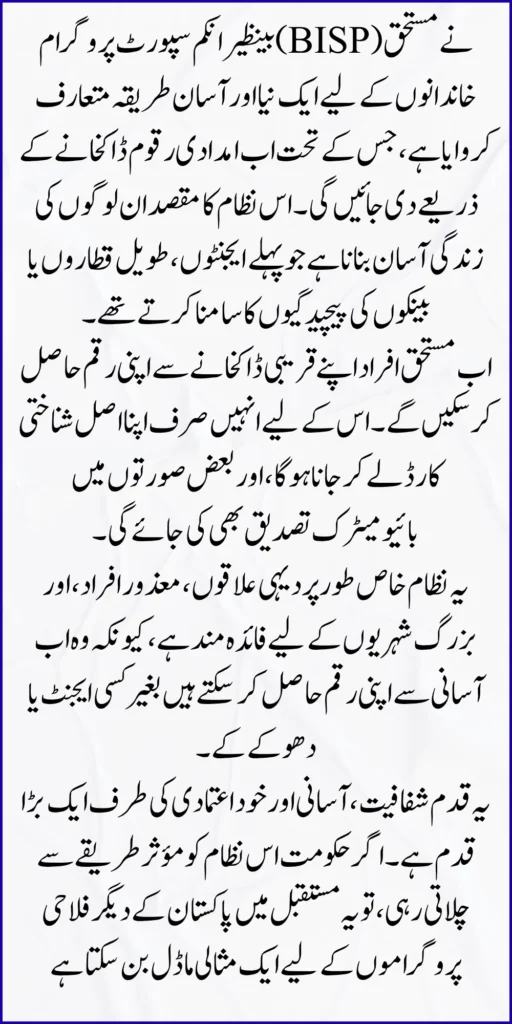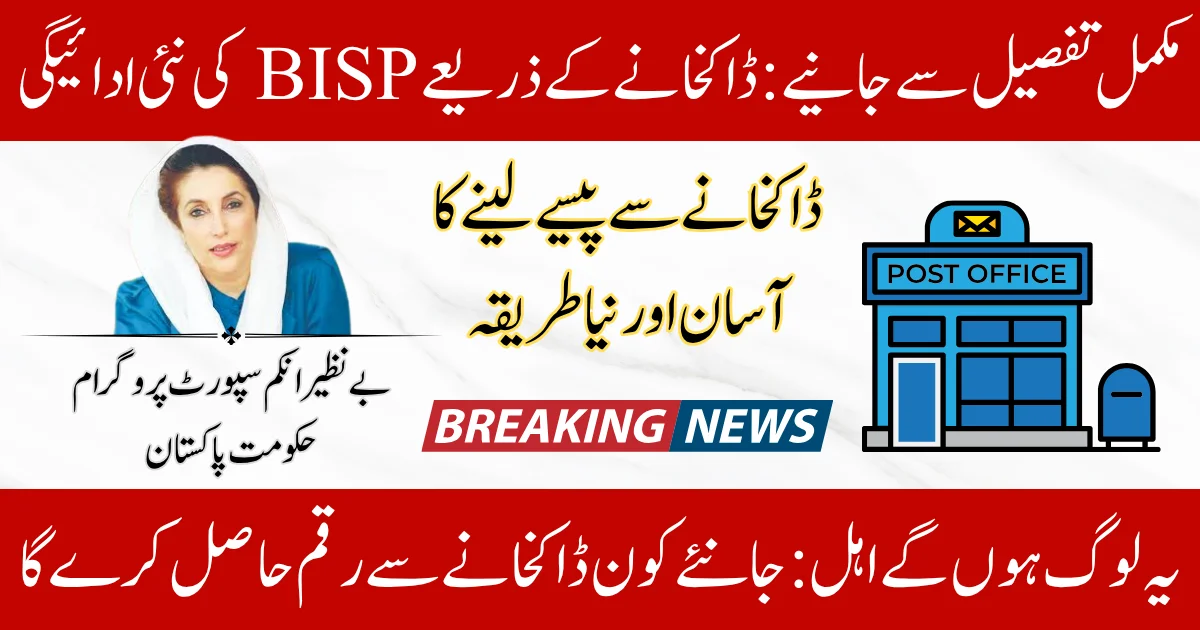BISP Launches New Post Office Payment Method A Game Changer for Beneficiaries
In a significant shift aimed at simplifying the lives of millions of low-income families across Pakistan, the Benazir Income Support Programme (BISP) has introduced a new payment system through post offices. This new initiative comes as a ray of hope for beneficiaries who previously faced long queues, delays, and unclear procedures while trying to receive their payments.
With the inclusion of Pakistan Post in the disbursement process, the government is not only expanding access but also trying to make the process more dignified, secure, and transparent for everyone involved.
Why Change the System?
Previously, BISP beneficiaries were dependent on agents, franchises, or bank outlets to collect their quarterly payments. While these systems helped reach large populations, they also presented numerous challenges:
- Long wait times
- Technical system errors
- Middlemen demanding unauthorized cuts
- Lack of proper identity verification
- Limited reach in rural or remote areas
By involving post offices, the government aims to bridge the gap between financial aid and accessibility—particularly for elderly, disabled, and rural beneficiaries who found it difficult to travel or understand complex digital systems.
Also Read About : BISP Phase 2 Payments Begin Who Qualifies and Who’s Left Out?
How Will the Post Office System Work?
The new model is relatively straightforward: BISP will issue payment orders that beneficiaries can collect from their nearest designated post office branch. Each recipient will be notified via SMS (usually from 8171) that their payment is ready for collection. They will need to bring a valid CNIC and, in some cases, biometric verification may be required.

To prevent fraud and confusion, the system has been designed to ensure that only registered beneficiaries whose identity is verified can collect the money. In addition, Pakistan Post has set up special counters and simplified procedures exclusively for BISP payments.
Also Read About : BISP 938 Error Fixed Get Rs.13,500 Easily Now
A Real-Life Scenario
Consider the case of Parveen Bibi, a 65-year-old widow living in a small village in Punjab. Earlier, she would have to pay someone to accompany her to the city to access her payment. Sometimes, she was told her money wasn’t available yet even when it was. Now, with the post office system, she can simply walk to the nearby post branch, show her ID, and receive her stipend without intermediaries.
This kind of direct access is what the system is designed for to empower the most vulnerable segments of society with dignity and simplicity.
Also Read About : Good News : BISP Payment Now Through JazzCash Shops
Who Benefits Most?
While all registered beneficiaries stand to gain from this new system, the biggest advantage is for people in underdeveloped or rural regions where traditional banking infrastructure is scarce. Many elderly women, widows, and people with disabilities often depend on relatives or agents to help them through the process. Now, they can rely on a more trustworthy institution that is physically closer and officially accountable.
Moreover, by reducing dependency on third parties, the system minimizes the chances of fraud or exploitation issues that have plagued social welfare systems for decades.
Also Read About : BISP Payment Issue Fixed, Get Your Rs.13,500 Now
Challenges Ahead
While this transition holds promise, it will require robust coordination and public awareness. Some possible challenges include:
- Inadequate training of post office staff
- Delays in system updates or integration
- Confusion among beneficiaries unfamiliar with the new process
- Logistical issues in densely populated or underserved regions
To address these, the government and BISP authorities are planning information campaigns, helplines, and field teams to help people adapt smoothly.
Also Read About : BISP 8171 April Payment District Schedule 2025
What Should Beneficiaries Do?
If you are a registered BISP recipient, here are simple steps to follow:
- Wait for an SMS notification from 8171 confirming your payment.
- Take your original CNIC to the nearest designated post office.
- Confirm your identity through fingerprint or CNIC verification.
- Collect your payment and ensure you receive the full amount.
- Report any suspicious activity or delays to the BISP helpline.
Do not share personal details with anyone claiming to “help” with payments. The new system is built to be simple enough that no third-party involvement is necessary.
Also Read About : BISP Announce New Phase 13500 Payment Check Now
A Step Toward Dignity and Empowerment
The launch of BISP payments through post offices represents more than a shift in logistics—it is a transformative step toward inclusivity and human dignity. By involving trusted public institutions like Pakistan Post, the program places power back into the hands of its rightful recipients.
For the millions relying on BISP to survive and support their families, this move offers more than convenience—it provides hope, respect, and a smoother future.
Also Read About : Bewa Sahara Card 2025 Registration Eligibility Criteria 2025
Final Thoughts
The integration of Pakistan Post into the BISP payment system is a landmark decision that reflects the government’s commitment to transparency, accessibility, and respect for the underprivileged. It simplifies the payment process, reduces corruption risks, and restores control to the hands of those who need it most.
While every system faces initial challenges, this new method has the potential to become a model for future welfare programs in Pakistan. If implemented effectively with clear communication and ongoing support this could be the beginning of a more inclusive and efficient era of social protection.
The success of this initiative ultimately depends not just on technology or institutions, but on the trust and awareness built between the government and its citizens.

